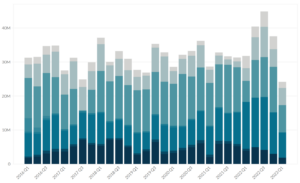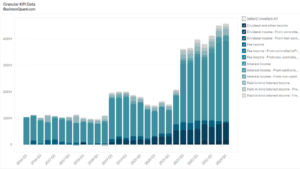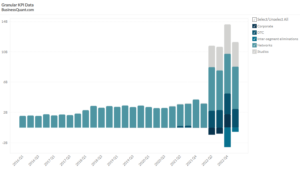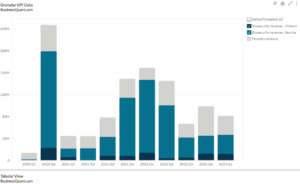
Shopify’s Revenue Breakdown by Segment (2016-2023)
Exclusive Data
You need the Pro Plan to access KPI data
- Full access to the platform
- KPI data & segment financials on US stocks
- Financial data on thousands of stocks
- Download data in xlsx and csv formats
Pro Plan
$49 per month*
60% discount ends in:
.
About
More information
Subscribe to Pro or Enterprise plans to unlock this feature.
Contact the Analyst
Subscribe to Pro or Enterprise plans to unlock this feature.
Become a smarter investor today.
Access KPIs & Segment Financials on US stocks
This statistic highlights Shopify’s Revenue Breakdown by Segment, split across Merchant Solutions and Subscription Solutions, reported on a quarterly basis.
When the Company’s service is made available to the merchant then the Revenue recognition begins on that date. Payments are recorded as deferred revenue when payments are received in advance of services being rendered and recognized on a rateable basis over the requisite service period. The Company earns revenue based on its services either directly to its merchants or indirectly through resellers.
Shopify’s Revenue Breakdown by Segment
| Segment | Q4 2020 | Q3 2021 | Q4 2021 | Contribution in Q4 2021 |
| Merchant solutions | $698.30 | $787.53 | $1,028.82 | 74.55% |
| Subscription solutions | $279.44 | $336.21 | $351.21 | 25.45% |
| Total | $977.74 | $1,123.74 | $1,380.02 | 100.00% |
(all figures in millions, except percentages)
Shopify’s total revenue increased from $977.74 million in Q4 2020 to $1,380.02 million in Q4 2021, indicating a 41.14% growth on a year-on-year basis. The revenue in Q4 2021 increased by 22.81% i.e. from $1,123.74 million in Q3 2021 to $1,380.02 million in Q4 2021.
Shopify generates revenue from the following segments:
Merchant Solutions
The Company generates merchant solutions revenue from fees that it charges merchants on their customer orders which are processed through Shopify Payments. This accounts for the majority of the company’s income. The Company also derives merchants solutions revenue from Shopify Shipping, other transaction services, referral fees, and the sale of Point-of-Sale (POS) hardware. For the sale of POS hardware, when the title passes to the merchant, revenue is recognized by the shipping terms.
Revenues are recognized at the time of transactions that are earned from Shopify Payments, Shopify Shipping, other transaction services, and referral fees.
Shopify revenue from Merchant Solutions increased by 47.33% from $698.30 million in Q4 2020 to $1,028.82 million in Q4 2021 on a year-on-year basis. It also grew by 30.64% on a quarter-on-quarter basis, i.e. from $787.53 million in Q3 2021 to $1,028.82 million in Q4 2021. This segment contributed to 74.55% of the company’s total revenue in Q4 2021.
Subscription Solutions
On a rateable basis over the contractual term, Subscription revenue is recognized. The terms range from multi-year subscriptions to annual or monthly terms. Each of their subscription solutions has standalone value, as the solutions are sold separately. Accordingly, they consider the separate units of accounting in multiple deliverable arrangements to be the subscription fees, themes, apps, and domain names.
Revenue from Apps and Domains, as well as Themes, have been classified within Subscription solutions. It is on the basis that they are typically sold at the time the merchant enters into the subscription services arrangement. It is also charged because they are charged regularly.
They have not established VSOE for subscription solutions due to a lack of pricing consistency, the introduction of new services, and other factors.
Shopify revenue from Subscription Solutions increased by 25.68% from $279.44 million in Q4 2020 to $351.21 million in Q4 2021 on a year-on-year basis. It also grew by 4.46% on a quarter-on-quarter basis, i.e. from $336.21 million in Q3 2021 to $351.21 million in Q4 2021. This segment contributed to 25.45% of the company’s total revenue in Q4 2021.
About the Company
Shopify provides a multi-channel commerce platform designed for small and medium-sized businesses. It is the leading cloud-based platform. Merchants use their software to run their business across all of their sales channels, including web and mobile storefronts, social media storefronts, and physical retail locations. The importance of a multi-channel platform that is both fully integrated and easy to use increases as the number of channels over which merchants transact continues to expand. The Merchants get a single view of their business and customers across all of their sales channels through the Shopify platform and It also enables them to manage products and inventory, ship orders, build customer relationships, process orders, and payments, and leverage analytics and reporting all from one integrated back office.
They built their platform to address merchants’ growing challenges to make previously complex tasks simple. Their platform provides merchants with an intuitive user experience that requires no up-front training to implement and use.
Did you like Shopify’s Revenue Breakdown by Segment statistic?
Access more such KPI data points and segment financials on thousands of US stocks, with Business Quant.
You can get started here.
More data on US Stocks

Our Plans
Always know what you’ll pay. No hidden costs or surprises.
- Annual
- Monthly
60% discount till April 30
Pro
For serious investing
-
Company KPI data Access segment financials, non-GAAP metrics and KPI data from presentations and filings. Examples include financials by segment / region / product category, AT&T's broadband subscriber trends, Tesla's deliveries by model and lots more.
-
Stock research tools Features include : stock screener, stock comparison, industry financials, stock warnings, advanced charting tools, timeseries tables, scatter charts, financial statements, stock reports, SEC filings, stock ratings, institutional and insider ownership data. There are 200+ financial items and ratios on thousands of US stocks.
-
Industry data & tools Access premium operating data on 40+ industries. Examples include market share, smartphone shipments by vendor, subscribers by wireless carrier, historical gold production. There are 20,000+ such statistics.
Enterprise
For tailored workflows
-
All of Pro plan Get unfettered access to all our dashboards and dossiers.
-
Custom built features Get tailored dashboards built specially for you , based on your set of requirements, to simplify your research workflow.
-
Admin billing Back-end documentation support and multi-seat licensing.
* Billed annually, local taxes extra.
60% discount on Annual plan
Pro
For serious investing
-
Company KPI data Access segment financials, non-GAAP metrics and KPI data from presentations and filings. Examples include financials by segment / region / product category, AT&T's broadband subscriber trends, Tesla's deliveries by model and lots more.
-
Stock research tools Features include : stock screener, stock comparison, industry financials, stock warnings, advanced charting tools, timeseries tables, scatter charts, financial statements, stock reports, SEC filings, stock ratings, institutional and insider ownership data. There are 200+ financial items and ratios on thousands of US stocks.
-
Industry data & tools Access premium operating data on 40+ industries. Examples include market share, smartphone shipments by vendor, subscribers by wireless carrier, historical gold production. There are 20,000+ such statistics.
Enterprise
For tailored workflows
-
All of Pro plan Get unfettered access to all our features.
-
Custom built features Get tailored dashboards built specially for you , based on your set of requirements, to simplify your research workflow.
-
Admin billing Back-end documentation support and multi-seat licensing.
* Local taxes extra.






